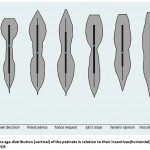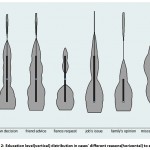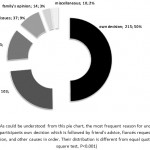Manuscript accepted on : 24 November 2016
Published online on: --
Plagiarism Check: Yes
Psychosocial Motivations of Young Females for Seeking Primary Cosmetic Nasal Surgery
Hashem Shemshadi1 , Hadi Motamedi1 and Ramin Beiranvand2
1University of Social Welfare and Rehabilitation Sciences, Rofeidah Rehabilitation Hospital, Tehran, Iran.
2University of Shahid Beheshti Medical Sciences, Tehran, Iran.
Corresponding Author E-mail: shemshadii@gmail.com
DOI : http://dx.doi.org/10.13005/bbra/2402
ABSTRACT: The Primary Cosmetic Nasal Surgery (PCNS) is one of the most frequent operations in the field of plastic surgery. The aim of this study was to examine the psychosocial reasons for young females who are seeking to undergo PCNS for alternating their facial appearance. This was a retrospective, cross- sectional survey. We referred to the 2440 patients who had undergone PCNS by the main author at the Tehran Pasargad Hospital during 1996-2012.From the initial sample, 430 single healthy females, ages 20-30 with minimum of 12 years of education were entered the survey. We focused on their answers in the psychosocial chart which developed based on the Erik Erikson`s theory of psychosocial development (1959). Their different motivations for undergoing PCNS (own-decision, friend-advice, fiancé-request, job-issue, family-encouragement and miscellaneous) were collected and analyzed via SPSS version 16. The patients` average age and educational levels were 23±1 and 13±1 respectively. Their psychosocial concerns for seeking PCNS were: own-decision (50%), friend-advice (24%), fiancé request (12%), job issue (9%), family- opinion (3%) and miscellaneous (2%). Based on this survey, one may presume that patients` own-decisions were the most common concern for young females who seek for PCNS. Reasons of (friend- advice, fiancé- request, job- issue, family- opinion and the miscellaneous) were from the high to low considerations for seeking PCNS. Since these motivations may vary in different populations, related studies are recommended to find other psychosocial inspirations for choosing PCNS in different context.
KEYWORDS: psychology; psychosocial; cosmetic procedures; primary cosmetic nasal surgery; young female
Download this article as:| Copy the following to cite this article: Shemshadi H, Motamedi H, Beiranvand R. Psychosocial Motivations of Young Females for Seeking Primary Cosmetic Nasal Surgery. Biosci Biotech Res Asia 2016;13(4). |
| Copy the following to cite this URL: Shemshadi H, Motamedi H, Beiranvand R. Psychosocial Motivations of Young Females for Seeking Primary Cosmetic Nasal Surgery. Biosci Biotech Res Asia 2016;13(4). Available from: https://www.biotech-asia.org/?p=17357 |
Introduction
The Primary cosmetic nasal surgery (PCNS) is one of the most difficult while the most frequent operation performed in the field of cosmetic surgery (1). Most people who seek PCNS are females who are 15 times more than males(2). These females are motivated to consider PCNS, because they are more willing to go after their beauty and attraction, in compare to the males.
Some females may get encouraged to consider PCNS based on their own decision. They want to look beautiful, more attractive and more impressive for the sake of their own sense of well being. By choosing to consider PCNS, they feel good about themselves and gain more self confidence and self esteem during their social and cultural communication grounds (32, 33&34)(3, 4). In respect of a patients` decision for PCNS, there might be some real and some non-real issues. Having patients with non-real expectation in regard to their nose, is considered important in making their decision for undergoing PCNS. The patients may think of so many flaws in their nose which does not exist for real (5, 6).This latter situation creates more harm if PCNS applied, since there will be less patients` satisfaction, no matter how good is the PCNS result. They might think, there are many other flaws remained and need to be surgically solved(7).This recent issue will create a non-pleasant experience for the cosmetic surgeon and the patient both (8).In rare instances, such patient may undergo multiple operations with no ultimate satisfactory results. In some other rare instances, such patients may end up with severe depression and a possibility to commit suicide (9-11).
Being advised to consider PCNS by a friend is another important consideration. If the decision of undergoing a PCNS be obtained by other individual, possible surgical satisfaction may be less likely. Patients may have some underlying emotional and or even psychological problems which have caused them not to have enough self- esteem for undergoing PCNS based on their own decision (12). If such motivation initiated from a loved one such as fiancé, husband and or a boyfriend, bias may arise due to PCNS decisions may be logical for these loved ones, not for the patients themselves. Things which are beautiful and acceptable for some people, may not be attractive for the others (13, 14). It is not uncommon for an intimate relationship break after PCNS, since the surgical outcome may not be pleasing for the patient`s loved one (15). Family`s provoking an individual to consider PCNS seems to be more benign issue. If something goes wrong, the father, mother and siblings stay firmly to their loved ones` hassles which may have been caused by PCNS (16, 17).If the surgical result goes wrong, the patients self esteem, self confidence and their self identifications, decline (18).They may undergo anxiety, and neurotic reactions which need to be under a psychiatrist and or psychologist supervision (19).They may present with pains in their body parts, with no organic cause. Feelings of tension, , irrelevant thoughts, being worried not logical, and poor adjustment with other people, get worsen (20).It has been assumed that young females who seek PCNS, may have some underlying psychological problems (21).Most of them are really provoked by some logical decision for considering changes in their nose(22).Some of these young females may have some psychological dissatisfaction with their body image (23). Some of them seek logically for a better and a healthier way for alterations leading to their beauty (24).Most of the psychosocial factors may influence a young female to choose their nasal alterations by undergoing PCNS. Some societies demand more female attractions for their social communication influences, which in some other societies such issue is not considered seriously (25).Thus the concept of beauty and reasoning for the females in seeking PCNS, has a social and cultural relevancy (26). In initial consultation, the cosmetic surgeon must be careful about the patient realistic versus non-realistic expectations for undergoing PCNS (16).If a patient seeking cosmetic nasal surgery in order to have a similar nasal feature the same as an actress and or a friend, this is non-realistic alarm for the cosmetic surgeon who should consider seriously. Not two patients are alike and respond to the surgical procedures are not the same (27). These unrealistic conceptions in PCNS may be a sign for the cosmetic nasal surgeon, not to choose such patients as acceptable candidates for undergoing PCNS. Therefore a psychological and or a psychiatrist consultation may reveal their emotional and psychosocial disorders (24, 25).If such psychosocial deteriorations are not detected early, usually a satisfactory outcome will not be expected after the patients undergo PCNS (28, 29). However, the exact and definite ideal selection of these patients is impossible, but aforementioned cautions may reduce the potential disturbs prior to accepting such patients for PCNS considerations (30, 31).
Methods and Materials
This research was a retrospective, cross sectional and descriptive analytical survey. Our main goal was to examine the psychosocial reasons for young female, who seek for PCNS. We refereed to the Tehran Pasargad Hospital`s patient charts who had undergone PCNS during 1996-2012. Among 24440 initial charts, 430 cases based on the inclusion and exclusion criteria were selected. Their inclusion factors were ( female, healthy,single,age20-30 and undergone cosmetic nasal surgery for their first time).Excluded patients those who were married, females age below 20 and over 30 years, having underlying nasal or systemic diseases and had undergone cosmetic nasal surgery for more than one time. Their responses to the psychosocial reasons for considering PCNS were examined. The chart was created based on the validated and reliable Erik Erikson`s theory of human psychosocial development ( 1959-Stage 6).Based on this theory human being in the period of their young adulthood ( 18-40) try to share their values with their own society to gain psychosocial ideals (32,33& 34). We collected their different reasons for considering PCNS such as own-decision, friend-advice, fiancé request, job issue, family- opinion and miscellaneous for investigation. The gathered data analysed via SPSS version 16.
Results
The mean age and the educational levels of the patients were 23±1 and 13±1 respectively (Tables 1 &2). Among variety psychosocial factors to seek PCNS, the individual`s own-decision (50%) was the most frequent motive among other ideas (Figure 1). Also, based on this aforementioned figure, the other patients` psychological reasons to seek PCNS were followed by their friend`s advice (24%), fiancé`s request (12%), job issues (9%), family`s opinion (3%) and miscellaneous factors (2%). Most of the subjects within own-decision category(50%), were in their early 20`s and had earned at least 12 years of education. Their different motive distributions were varied in each above mentioned group and not equally scattered, as resulted via chi square test ( P<0.001).
 |
Table 1: The age distribution (vertical) of the patinets in relation to their incentives(horizontal) for seeking PCR |
 |
Table 2: Education level(vertical) distribution in cases` different reasons(horizontal) to seek PCR |
Discussion
Except in some religious believes, the female`s face is not usually been covered. Among the facial anatomical components, the nose is the most obvious site which is observed effortlessly during human communication. Considering such uncover facial anatomical part, any of its undesirable flaws, may get psychologically important for some individuals. For this latter reason, some people, especially younger females are seeking to alter these imperfections in order to have more acceptable facial appearance. In this survey, we focused on the young females in Iran who are more prone to seek for their nasal alteration by considering PCNS in compare to other groups. We perused their psychosocial reasoning behind their decisions toward looking for consultations and plan to undergo nasal cosmetic surgery. We found the females are usually more concern about PCNS than the males. Younger females are more willing to seek PCNS than the aged females. Single young females are more motivated to refer for the primary cosmetic nasal surgery, than single young males. Such determinations may be influenced by different cultural settings, in different societies.
 |
Figure 1: As could be understood from this pie chart, the most frequent reason for undertaking … surgery is participants own decision which is followed by friend’s advice, fiancés request, job issues, family’s opinion, and other causes in order. Their distribution is different from equal quotas of each (chi square test, P<0.001). |
Conclusion
People who are seeking PCNS are different in their age, sex, educational level and their main motive for such action. In this study we found the most initiative for a young, single woman for undergoing PCNS in Iran. We assume the most initiative factors for our study population may be based on their own decisions to search for considering PCNS. Their fiancé, friend, family and job issue play minor indicators for their decision..The last reason for seeking PCNS which is the miscellaneous causes to choose PCNS is not clear enough why the individual decides to undergo such surgery. The psychosocial provocative desires for the patients to seek PCNS, may be different in different societies. To assess the individual`s feasibility for undergoing PCNS, a cosmetic surgeon may evaluate every case individually and precisely. After reviewing their complete health history and their psychosocial status, their body and their nose`s physical exams must be applied thoroughly. In facing patients with psychosocial uncertainty, the psychologist and or the psychiatrist consultations must be deemed, prior to their selection for undergoing PCNS.
Acknowledgement
The authors extend their appreciation to the Tehran Pasargad Hospital Patient Recods, specially to Ms.Zahra Eftekhari. Special thanks also to Ms. Elizabeth Fearon, for her sincere assists in this manuscript`s English text corrections.
References
- Black PW. Rhinoplasty. Journal of the Medical Association of Georgia. 1991;80(11):577-82.
- Shulman O, Westreich M, Shulman J. Motivation for rhinoplasty: changes in 5970 cases, in three groups, 1964 to 1997. Aesthetic plastic surgery. 1998;22(6):420-4.
CrossRef - Macgregor FC. Social and cultural components in the motivations of persons seeking plastic surgery of the nose. Journal of health and social behavior. 1967;8(2):125-35.
CrossRef - Feiss R, Real JP. [Rhinoplasty: psychological aspects. Psychiatrist/surgeon collaboration. Apropos of 207 patients surgically treated 1 or more times between 1980 and 1986]. Annales de chirurgie plastique et esthetique. 1989;34(5):392-4.
- Strian F. [Dysmorphophobia–self concept and self identity]. Zeitschrift fur klinische Psychologie, Psychopathologie und Psychotherapie / im Auftrag der Gorres-Gesellschaft. 1984;32(2):117-22.
- Connolly FH, Gipson M. Dysmorphophobia–a long-term study. The British journal of psychiatry : the journal of mental science. 1978;132:568-70.
CrossRef - Conejo Garcia A, Moreno Pinilla M, Crespo Hervaz D, Saiz Ruiz J. [Complications of dysmorphophobia. Description of a self-mutilation case]. Actas espanolas de psiquiatria. 2006;34(3):202-5.
- Sarwer DB. Discussion: High prevalence of body dysmorphic disorder symptoms in patients seeking rhinoplasty. Plastic and reconstructive surgery. 2011;128(2):518-9.
CrossRef - Jerome L. Body dysmorphic disorder: symptom or syndrome. The American journal of psychiatry. 1994;151(3):460-1; author reply 1-2.
CrossRef - Stewart M. Psychosocial Problems of Patients Requesting Rhinoplasty. Transactions – American Academy of Ophthalmology and Otolaryngology American Academy of Ophthalmology and Otolaryngology. 1964;68:881-4.
- Schmidt J. Potential complications of nasal and sinus therapy. Medical trial technique quarterly. 1974;Annual(0):75-9.
- Shulman J, Westreich M. Rhinoplasty update: preoperative evaluation of 4,040 cases. Aesthetic plastic surgery. 1983;7(4):227-32.
CrossRef - Tasman AJ. The psychological aspects of rhinoplasty. Current opinion in otolaryngology & head and neck surgery. 2010;18(4):290-4.
CrossRef - Rohrich RJ. The who, what, when, and why of cosmetic surgery: do our patients need a preoperative psychiatric evaluation? Plastic and reconstructive surgery. 2000;106(7):1605-7.
CrossRef - Masters FW, Robinson DW. Cosmetic surgery. Correcting emotional, rather than functional, defects. The Journal of the Kansas Medical Society. 1966;67(3):128-33.
- Javo IM, Sorlie T. Psychosocial predictors of an interest in cosmetic surgery among young Norwegian women: a population-based study. Plastic surgical nursing : official journal of the American Society of Plastic and Reconstructive Surgical Nurses. 2010;30(3):180-6.
- Lejour M, Lecocq C. [Psychological implications of esthetic surgery. Apropos of a study of 68 cases]. Acta chirurgica Belgica. 1975;74(1):5-24.
- Bronheim H, Strain JJ, Biller HF. Psychiatric aspects of head and neck surgery. Part I: New surgical techniques and psychiatric consequences. General hospital psychiatry. 1991;13(3):165-76.
CrossRef - Thomas CS, Goldberg DP. Appearance, body image and distress in facial dysmorphophobia. Acta psychiatrica Scandinavica. 1995;92(3):231-6.
CrossRef - Guyuron B, Bokhari F. Patient satisfaction following rhinoplasty. Aesthetic plastic surgery. 1996;20(2):153-7.
CrossRef - Meyer L, Jacobsson S. Psychiatric and psychosocial characteristics of patients accepted for rhinoplasty. Annals of plastic surgery. 1987;19(2):117-30.
CrossRef - Stewart EJ, Robinson K, Wilson JA. Assessment of patient’s benefit from rhinoplasty. Rhinology. 1996;34(1):57-9.
- Baumann I. [Quality of life before and after septoplasty and rhinoplasty]. Laryngo- rhino- otologie. 2010;89 Suppl 1:S35-45.
CrossRef - Honigman RJ, Phillips KA, Castle DJ. A review of psychosocial outcomes for patients seeking cosmetic surgery. Plastic and reconstructive surgery. 2004;113(4):1229-37.
CrossRef - Javo IM, Sorlie T. Psychosocial characteristics of young Norwegian women interested in liposuction, breast augmentation, rhinoplasty, and abdominoplasty: a population-based study. Plastic and reconstructive surgery. 2010;125(5):1536-43.
CrossRef - Baumann I. Quality of life before and after septoplasty and rhinoplasty. GMS current topics in otorhinolaryngology, head and neck surgery. 2010;9:Doc06.
- Ambro BT, Wright RJ. Psychological considerations in revision rhinoplasty. Facial plastic surgery : FPS. 2008;24(3):288-92.
CrossRef - Adamson PA, Litner JA. Psychologic aspects of revision rhinoplasty. Facial plastic surgery clinics of North America. 2006;14(4):269-77, v.
- Alavi M, Kalafi Y, Dehbozorgi GR, Javadpour A. Body dysmorphic disorder and other psychiatric morbidity in aesthetic rhinoplasty candidates. Journal of plastic, reconstructive & aesthetic surgery : JPRAS. 2011;64(6):738-41.
CrossRef - Anderson JR. What Physicians Should Know About Nasal Plastic Surgery. The Journal of the Louisiana State Medical Society : official organ of the Louisiana State Medical Society. 1963;115:337-41.
- Alkhairy F. Art and science in aesthetic rhinoplasty. Aesthetic plastic surgery. 1993;17(1):37-41.
CrossRef - Weiner, M B (1979), “Caring for the elderly. Psychological aging: aspects of normal personality and development in old age. Part II. Erik Erikson: resolutions of psychosocial tasks”, The Journal of nursing care (1979 May) 12 (5): 27–8.
- Strozier, C B (1976), “Disciplined subjectivity and the psychohistorian: a critical look at the work of Erik H. Erikson”, The Psychohistory review (1976 Dec) 5 (3): 28–31.
- Brenman-Gibson, M (1997), “The legacy of Erik Homburger Erikson.”, Psychoanalytic review (1997 Jun) 84 (3): 329–35.

This work is licensed under a Creative Commons Attribution 4.0 International License.





